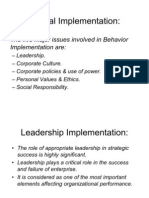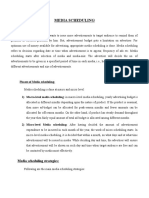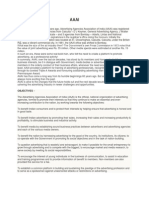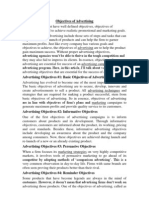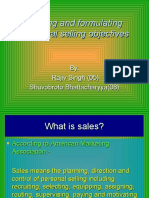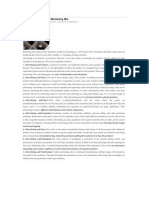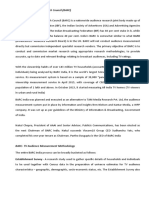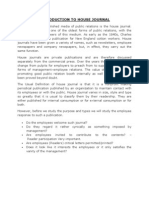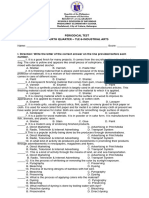Media Selection & Scheduling
Media Selection & Scheduling
Uploaded by
Surya BhaiCopyright:
Available Formats
Media Selection & Scheduling
Media Selection & Scheduling
Uploaded by
Surya BhaiCopyright
Available Formats
Share this document
Did you find this document useful?
Is this content inappropriate?
Copyright:
Available Formats
Media Selection & Scheduling
Media Selection & Scheduling
Uploaded by
Surya BhaiCopyright:
Available Formats
MEDIA SELECTION
Media selection is also called media planning. Media plan decides how advertising time and space in various media will be used to achieve the advertising objectives and marketing objectives of the company. The basic goal of media plan is to find out that combination of media which enables the advertiser to communicate the ad-message in the most effective manner at lower cost. An advertising plan is decided by the advertiser to achieve advertising objectives. Advertising objectives are decided keeping in view the marketing objectives of the company. Media plan is based on advertising plan. In other words media plan is a part of the overall advertising plan. In media plan following main media decisions are taken: Selecting suitable media to serve the advertisers need i.e., selecting media which can reach the target audience. Selecting best combination of mix of media which is within the advertisers ad-budget. Selecting most suitable media schedules.
Media planning helps to control wastage in advertising. It ensures the optimum utilization of resources spent on advertising.
Definition: According to Fryburger, Mediaplanning involves selecting appropriate media for carrying advertising message to target audience and deciding how much to spend on each media and scheduling when the advertisement is to run. Media-planning is a decision process regarding use of advertising time and space to assist in the achievement of marketing objectives. -- Wells Burnett
In brief, media planning includes the answer to following 5 Ws: Whom: Whom do we want to reach? i.e., identifying target audience Where: Where the potential customers located? i.e., identifying geographical area. What: What type of message is to be communicated? i.e., either the message is informative or demonstrative in nature. Which: Which media is to be selected for communicating with our potential consumers?
When: When is the ad need to be issued? i.e., deciding month, day and time of ad.
Factors affecting Media Selection: Following are the main considerations in media selection 1) Nature of product: product to be advertised can be industrial /technical product or
consumer product. Industrial and technical products can be better advertised in specific trade journals and magazines. Consumer products can be better advertised through mass media such as television, newspapers, outdoor advertising etc. 2) Nature of customers: an appropriate media plan must be considered in its type, no. of
consumers, for whom the advertising is to be done. Different consumers differ in the age group, sex, incomes, personality, educational level, attitude etc.
3)
Distribution of products: if the product is to be distributed locally or regionally then
media with local coverage and reach should be considered like local newspapers, cable-network. If the product is to be distributed on national level, then media with national coverage will be suitable.
4)
Advertising objectives: The main objective of every advertising campaign is to get
favorable response from customer, but the specific objectives can be different. If the objective of advertising campaign is to get immediate results then fast media of communication such as newspapers, banners, pamphlets will be considered.
5)
Nature of message: if the message is informative in nature, then newspaper will be
suitable. If ad-message is to persuade consumers then they need to be given emotional appeal, rational appeal, demonstration of product, then television is suitable.
6)
Size of ad-budget: if amount of advertisement budget is more, then costly media like
television, national dailies, and popular magazines can be selected.
7)
Media reach and coverage: such media should be selected which has wider reach and
can cover out target customers.
8)
Media cost: advertiser should compare the cost of each media by considering the no. of
audience covered by such media. It is possible that a media seems to be costly, but if it can cover large no. of audience, then cost per audience will be less.
Process and steps in media selection:
Media planning involves following steps:
To know about target audience
To consider various factors affecting media planning
To identify the geographical area
Establishing media objectives
Selecting suitable media
Selecting optimum media-mix
Media scheduling
Executing advertising program
Follow up and evaluation
Importance and advantages of Media Selection:
1) 2) 3) 4) 5) 6) 7) Optimum utilization of resources Helps in achieving advertising objectives Selection of appropriate media Selection of optimum media mix Helps in allocating advertising budget Ensures appropriate timing of advertising Helps in controlling inefficiency
MEDIA SCHEDULING
Every advertiser wants to issue more advertisements to target audience to remind them of products or services provided by him. But, advertisement budget puts a limitation on advertiser. For optimum use of money available for advertising, appropriate media scheduling is done. Media scheduling refers to decision regarding date or time when advertisement is to appear, frequency of ads etc. Media scheduling starts after selection of media and media-mix. The advertiser will decide the no. of advertisements to be given in a specified period of time in each media, i.e., he will decide the timegap in different advertisements and size of advertisements.
Phases of Media scheduling: Media scheduling is done at macro and micro level: 1) Macro-level media scheduling: in macro-level media scheduling, yearly advertising budget is allocated in different months depending upon the nature of product. If the product is seasonal, then more ad-budget can be allocated for peak-season months and fewer amounts can be allocated for off-season months. On the other hand, if product has steady demand throughout the year then fairly equal amount of total ad-budget is allocated among different months.
2) Micro-level Media scheduling: After having decided the amount of advertisement expenditure to be incurred in each month of the year, the work of micro-scheduling starts. In micro-level media scheduling, it is decided that within a month, on what days and at what time advertisement will be issued in media. While deciding day and time, the advertiser will ensure that advertisement will be
shown on such day and time when target-audience are free and can be contacted by media most effectively.
Media scheduling strategies:
Following are the main media scheduling strategies:
1) Continuous Option: Under this strategy advertisement will run throughout the year. The amount of advertising budget is divided equally among different months. This strategy is usually used for the products which are sold during the year and for products of daily use. For example, for tooth paste, shampoo, soaps, etc., continuous-option is adopted. In this strategy, advertising is done on a regular pattern without gaps i.e., there is no non- advertising period. This strategy helps the advertiser in constantly reminding the target audience about its product. But in this strategy, advertising is not decided on the basis of actual requirements; rather ad-expenditure is spread evenly throughout the year. It may result in over advertising in a period when less advertising is required and under advertising in a period when more advertising is required.
2) Flighting option: This strategy refers to advertising in time gaps. At some time periods, there is heavy advertising and at other time there is no advertising, i.e., advertising in a certain period and advertising not at all in another period. This strategy is adopted by companies selling seasonal and festival related products like air conditioners, woolen garments, crackers, etc. In this strategy, advertising is done in accordance with purchase cycles. Here, continuous advertising is not done; rather advertising is done in flights. This will reduce advertisement expenses.
3) Pulsing option: In this strategy advertisement will run throughout the year. But at certain time period; ad expenses will be less and at other time period, ad expenses will be more. In this option continuity of advertising is made, but the amount of ad expenses is not same throughout the year. In this option there is no non-advertising period. This option removes the limitations of continuous option and flighting option. This is better than the first 2. In media scheduling strategies, pulse rate of advertisement is also decided. Pulse rate refers to the time gap between 2 advertisements. Pulse rate can be any one of the following: Seasonal pulse: ad is released more frequently in seasonal months and less in off-seasons.
Start up pulse: more frequent advertising is done at the time of launching a new product or service and then frequency of ads are reduced to normal levels. Special pulse: these ads are spaced irregularly, i.e., very heavy advertising is done in a particular period of time and less advertising in other time periods.
Factors affecting media scheduling: Nature of products Nature of target audience Stage of Product Life Cycle Competitors scheduling Advertising budget Rating of different T.V. programmes Government policies
You might also like
- Advertising 4TH SemDocument16 pagesAdvertising 4TH Semxyz_17127476750% (8)
- Marketing Management Bba NotesDocument34 pagesMarketing Management Bba NotesAbdul Lathif63% (8)
- Promotional Strategies Adopted by TupperwareDocument62 pagesPromotional Strategies Adopted by TupperwareShahzad Saif100% (1)
- Public Relations Ba (JMC) NotesDocument52 pagesPublic Relations Ba (JMC) Notesxyz_17127476791% (11)
- Classification of AdvertisingDocument9 pagesClassification of Advertisingutcm77100% (4)
- Media Planning NotesDocument112 pagesMedia Planning NotesTroy WhitakerNo ratings yet
- Mba IV Integrated Mrketing Communication (12mbamm417) NotesDocument59 pagesMba IV Integrated Mrketing Communication (12mbamm417) Notesamoghvkini83% (18)
- Advertising in Contemporary SocietyDocument17 pagesAdvertising in Contemporary SocietySujeet Mahto100% (2)
- Factors Affecting Media SelectionDocument2 pagesFactors Affecting Media SelectionSukesh R88% (8)
- Imc Unit 1 6 Notes.Document48 pagesImc Unit 1 6 Notes.Akshay Vk100% (3)
- Definitions of AdvertisingDocument9 pagesDefinitions of AdvertisingKLINIK TRIMEDIKANo ratings yet
- Promotion DecisionDocument37 pagesPromotion Decisionsamrulezzz100% (6)
- Advertising BudgetDocument2 pagesAdvertising BudgetAnonymous H0SJWZE8100% (1)
- Functional and Operational ImplimentationDocument47 pagesFunctional and Operational ImplimentationVandana Sharma100% (4)
- UNIT 4 Service Delivery and PromotionDocument14 pagesUNIT 4 Service Delivery and PromotionBala Subramani100% (4)
- Issues and Challenges in Service MarketingDocument10 pagesIssues and Challenges in Service MarketingDivya GirishNo ratings yet
- Behavioural ImplementationDocument31 pagesBehavioural ImplementationKirti Jaiswal83% (18)
- Another Busy Day: What's The Story?Document16 pagesAnother Busy Day: What's The Story?Vladimir OrozcoNo ratings yet
- Media SchedulingDocument3 pagesMedia SchedulingSukesh RNo ratings yet
- DAGMAR ApproachDocument2 pagesDAGMAR Approachrakshit123100% (3)
- Aaai & AsciDocument10 pagesAaai & AsciHiral Pandhi0% (1)
- Steps in Advertising ProcessDocument2 pagesSteps in Advertising ProcessSukesh R100% (1)
- Mcom Sem 4 Advertising NotesDocument100 pagesMcom Sem 4 Advertising Notesprathamesh gadgilNo ratings yet
- Chapter-3 (A) Building of Advertising ProgrammeDocument31 pagesChapter-3 (A) Building of Advertising ProgrammeSonia100% (1)
- Chapter-1: Advertising BudgetDocument30 pagesChapter-1: Advertising BudgetHarman PreetNo ratings yet
- Advertising BudgetDocument12 pagesAdvertising BudgetSurya BathamNo ratings yet
- BOA - Unit 2 - Creativity in AdvertisingDocument6 pagesBOA - Unit 2 - Creativity in AdvertisingAnjali NolkhaNo ratings yet
- Objectives of AdvertisingDocument26 pagesObjectives of Advertisingpratikpawar100% (1)
- Setting and Formulating Personal Selling Objectives 05,08Document12 pagesSetting and Formulating Personal Selling Objectives 05,08rajivs0911100% (1)
- What Are The Methods of Setting Advertising Budget?Document3 pagesWhat Are The Methods of Setting Advertising Budget?Jykyll PaulNo ratings yet
- Role of Advertising in Marketing MixDocument6 pagesRole of Advertising in Marketing MixAshutosh Agrahari0% (1)
- Advertisement and Media Management NotesDocument103 pagesAdvertisement and Media Management NotesKUSUMA A100% (1)
- Advertisement ManagementDocument18 pagesAdvertisement ManagementashokdgaurNo ratings yet
- Integrated Marketing Communication (14mbamm408) NotesDocument65 pagesIntegrated Marketing Communication (14mbamm408) NotesAnonymous uxd1yd100% (2)
- Advertising As Tool of CommunicationDocument10 pagesAdvertising As Tool of Communicationruchi goelNo ratings yet
- Advertising Management NotesDocument24 pagesAdvertising Management NotesJikz ZatNo ratings yet
- Basics of Advertising 202Document81 pagesBasics of Advertising 202Lavanya AggarwalNo ratings yet
- Unit-IV Media Measurement ToolsDocument3 pagesUnit-IV Media Measurement ToolsJatin VermaNo ratings yet
- Factors Affecting Promotion MixDocument24 pagesFactors Affecting Promotion MixSantosh ChaudharyNo ratings yet
- Barc, Wam, RamDocument3 pagesBarc, Wam, RamJatin Verma100% (2)
- Legal Aspects of Advertising in IndiaDocument29 pagesLegal Aspects of Advertising in IndiaDehradun Moot100% (1)
- Social, Ethical and Legal Aspects of AdvertisingDocument2 pagesSocial, Ethical and Legal Aspects of AdvertisingJaskaran Singh33% (3)
- Delivering Service Through Intermediaries and Electronic ChannelsDocument10 pagesDelivering Service Through Intermediaries and Electronic ChannelsDr Rushen Singh100% (2)
- Unit 6 Advertising Copy and Design Strategy: StructureDocument23 pagesUnit 6 Advertising Copy and Design Strategy: StructureSarlaJaiswalNo ratings yet
- PPT-6 Advertising BudgetDocument10 pagesPPT-6 Advertising BudgetBoman Tir100% (1)
- Message Design & DevelopmentDocument17 pagesMessage Design & DevelopmentRam Naresh Singh50% (2)
- History of Advertising in IndiaDocument33 pagesHistory of Advertising in IndiaShivlal Yadav100% (5)
- Introduction To House JournalDocument5 pagesIntroduction To House JournalHarsha Pursnani67% (3)
- Ad Layout - Principles and StagesDocument18 pagesAd Layout - Principles and StagesAvinash SupkarNo ratings yet
- Magic Multiplier & Empathy Magic Multiplier & EmpathyDocument9 pagesMagic Multiplier & Empathy Magic Multiplier & EmpathyjjhjhjNo ratings yet
- Advertising Management: NotesDocument47 pagesAdvertising Management: NotesPradheep Ramakrishnan100% (1)
- Major Players in AdvertisingDocument41 pagesMajor Players in Advertisingshanu_vijayan185482% (22)
- Advertising: - Defining Advertising - Need - Scope - ObjectivesDocument16 pagesAdvertising: - Defining Advertising - Need - Scope - Objectivesdharm287No ratings yet
- Mba III Services Management (14mbamm303) NotesDocument113 pagesMba III Services Management (14mbamm303) NotesZoheb Ali K100% (15)
- Advertising LayoutDocument15 pagesAdvertising LayoutAbhishek Soni100% (1)
- Advertising PlanningDocument3 pagesAdvertising PlanningNadeeraMohammedIsmail0% (1)
- Media PlanningDocument5 pagesMedia PlanningHIMANSHU DARGANNo ratings yet
- Hand Outs Advertising Chapter 5Document10 pagesHand Outs Advertising Chapter 5JEAN KIMBERLY DE GUZMANNo ratings yet
- Define Media Planning Also Explain Steps in Development of Media PlanDocument3 pagesDefine Media Planning Also Explain Steps in Development of Media PlanJatin VermaNo ratings yet
- 18bba63c U2 PDFDocument10 pages18bba63c U2 PDFThangamani.R ManiNo ratings yet
- Media Planning NotesDocument96 pagesMedia Planning NotesKRUSHI MOTANo ratings yet
- Media PlanningDocument139 pagesMedia PlanningNidhi_Jain11100% (3)
- Periodical Test Grade 6Document3 pagesPeriodical Test Grade 6Archord Drohcra MagsombolNo ratings yet
- Greenpeace Lego Report 2014Document15 pagesGreenpeace Lego Report 2014edienews100% (1)
- Advisory On Misleading AdvertisementDocument2 pagesAdvisory On Misleading AdvertisementmakNo ratings yet
- Competitivesigns C...Document7 pagesCompetitivesigns C...abhishekkmishra50No ratings yet
- Marketing Communications (MarCom) StrategyDocument10 pagesMarketing Communications (MarCom) Strategybibinbabu0032No ratings yet
- Cit452 Visual Analysis Nur Aliza Akasha 2022964141Document16 pagesCit452 Visual Analysis Nur Aliza Akasha 2022964141Arif FitriNo ratings yet
- NotesDocument25 pagesNotesShahana ThasinNo ratings yet
- Netflix Final ProjectDocument20 pagesNetflix Final Projectapi-539450896No ratings yet
- 7 Steps To Develop An Effective Marketing Communications StrategyDocument3 pages7 Steps To Develop An Effective Marketing Communications StrategyMaraNo ratings yet
- Argumentative Essay PowerpointDocument47 pagesArgumentative Essay Powerpointapi-354615285100% (1)
- Imagine - John Lennon - CIFRA CLUBDocument3 pagesImagine - John Lennon - CIFRA CLUBSarah SousaNo ratings yet
- Managerial Ethics GMT-8704 Case Study Assignment MBA Semester 3Document4 pagesManagerial Ethics GMT-8704 Case Study Assignment MBA Semester 3Virat ĆhoudharyNo ratings yet
- Ad PlanDocument11 pagesAd PlanshwetamitbatraNo ratings yet
- Sales StrategyDocument10 pagesSales Strategyappuzzop03No ratings yet
- Poster AdvertisingDocument210 pagesPoster AdvertisingMarco DiotalleviNo ratings yet
- Edexcel Business Studies A Level CourseworkDocument8 pagesEdexcel Business Studies A Level Courseworkf5ddpge2100% (2)
- MIL L-Media Information ManipulationDocument3 pagesMIL L-Media Information Manipulationclain100% (1)
- Revised - Paper - Style - BA - Sem - 3 To 6 - Gen English - 22-23Document2 pagesRevised - Paper - Style - BA - Sem - 3 To 6 - Gen English - 22-23Shlok RathodNo ratings yet
- Creating Powerful Brands Through Communication: Dr. Richa VyasDocument15 pagesCreating Powerful Brands Through Communication: Dr. Richa VyasRicha 'sharma' VyasNo ratings yet
- Web Ads & AdvertisingDocument20 pagesWeb Ads & AdvertisingVishal DeyNo ratings yet
- Đề HSG 9 2019-2020Document6 pagesĐề HSG 9 2019-2020phuongngauwu0411No ratings yet
- Promotion & DistributionDocument18 pagesPromotion & DistributionKertik SinghNo ratings yet
- One FC Bayern - One LogoDocument4 pagesOne FC Bayern - One LogokathleengodoyNo ratings yet
- Nike Marketing DissertationDocument8 pagesNike Marketing DissertationPayToDoMyPaperCanada100% (1)
- As En6 Q2 W3 D5Document5 pagesAs En6 Q2 W3 D5Diyonata KortezNo ratings yet
- Unit-10 International AdvertisingDocument11 pagesUnit-10 International Advertisingbhar4tp100% (1)
- Advertising Block 1Document119 pagesAdvertising Block 1syedrazaaNo ratings yet
- Marketing Communication Decisions:: Public RelationsDocument1 pageMarketing Communication Decisions:: Public RelationsArun KumarNo ratings yet
















